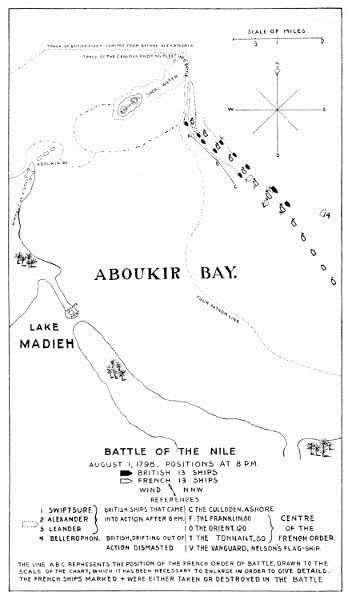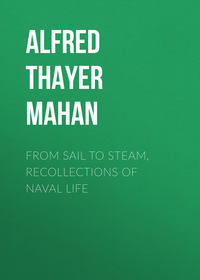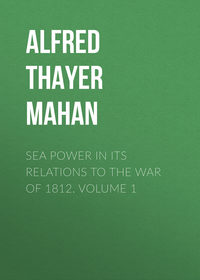 полная версия
полная версияThe Influence of sea Power upon the French Revolution and Empire 1793-1812, vol I
During the year 1797 no British fleet, and, with the rare exception of one or two scattered cruisers, no British ship-of-war, had entered the Mediterranean. The gathering of the Spanish navy at Cadiz, and of the greater part of the French in Brest, with the apparent design to invade Ireland or England, had dictated the concentration of the British navy before those two ports; either immediately, as St. Vincent at Cadiz, or by the dispositions—less fitted to compass their purpose—of the Channel fleet, by which bodies of ships were gathered at points other than Brest, with the hope of combining them against any sortie from that port. Great Britain, during the time following St. Vincent's retreat from the Mediterranean, was in the position of a nation struggling for existence,—for so she felt it, 174 —which had been compelled to contract her lines through loss of force, due to the gradual submission of her allies to her enemies. To this had further conduced the threatening attitude of the Dutch navy in the Texel, requiring a strong North Sea fleet. To her other embarrassments had been added, in this year of distress, the extensive mutinies in the navy. Though appeased in some instances and quelled in others, the spirit which caused them still existed. Under these circumstances Bonaparte, in 1797, had met no naval obstacle to his plans for the control of the Mediterranean, which had, moreover, been so covert as to escape detection. Admiral Brueys had gone from Toulon to the Adriatic, remained there several months, and returned in peace; and all minor naval movements went on undisturbed. The destiny of Corfu was not revealed till the end of the year; the purpose to get hold of Malta, seriously entertained by Brueys at the instigation of Bonaparte, 175 never transpired; and the talk about the army of England combined with the actual positions of the allied fleets to retain the British in the same stations. Toward the end of 1797 several circumstances occurred to relieve the pressure. In October Admiral Duncan inflicted upon the Dutch fleet, off the Texel, a defeat so decisive and complete as to throw it out of the contest for a long time. Of fifteen ships opposed to him, nine were taken. The condition of the French fleet in Brest, if not accurately known to be as bad as Bonaparte represented it, 176 was still sufficiently understood. No attempt had been made during the summer or winter of 1797 to renew the Irish expedition; and when the opening spring of 1798 permitted the Channel fleet in a body to keep the sea, the ministry felt it safe to detach a force to the Mediterranean.
Sir Horatio Nelson sailed from England on the 10th of April, and joined the fleet off Cadiz on the 30th. Lord St. Vincent welcomed him gladly, and at once sent him with three ships-of-the-line to the Mediterranean, to watch the impending armament, and, if possible, learn its destination. Nelson left the fleet on the 2d of May, the day before Bonaparte quitted Paris. On the 17th, having been unavoidably delayed at Gibraltar, he was in the neighborhood of Toulon, and captured a French corvette just leaving port; from which he learned particulars as to the naval force of the enemy, but nothing as regarded its destination. On the night of the 20th, in a violent gale of wind, his own ship was dismasted and with difficulty saved from going ashore. By great exertions she was towed by her consorts into the San Pietro Islands, at the south end of Sardinia, where she anchored on the 23d. On the 19th Bonaparte had sailed with the Marseille and Toulon divisions of the expedition. He was to be joined on the way by the detachments from Genoa, Corsica, and Civita Vecchia,—the total number of troops amounting to between thirty and thirty-five thousand.
On the same day that Nelson parted from St. Vincent, May 2, the admiralty wrote to the latter that it was essential to send twelve ships-of-the-line into the Mediterranean to counteract the French armament; and that to replace them eight ships had been ordered from England. A private letter from the First Lord, by the same mail, authorized St. Vincent to take his whole force for this object, if necessary, but hoped a detachment would be sufficient. In the latter case, while the choice of its commander was left to the admiral, it was intimated that Nelson, though junior to two other flag-officers, was by all means the proper man. Jervis had already made the same decision; and now at once told off and prepared the nine ships-of-the-line, forming the inshore squadron of the blockade, to start the moment the expected re-enforcement arrived. The junction of the latter with the main fleet was made May 24, out of sight of the port; and during the night Captain Troubridge sailed with the inshore ships, their places being taken by vessels similarly painted, so that no suspicion of the transaction might arise in Cadiz. On the 7th of June Troubridge joined Nelson, having picked up two more ships by the way; so that the British were now thirteen seventy-fours and one of fifty guns. By a very strange fatality, however, the frigates at first with Nelson had parted company the night his ship was dismasted, and had never rejoined. Troubridge brought only one little brig; and, as it was inadmissible to scatter the ships-of-the-line, the want of lookout vessels seriously affected all Nelson's movements in the long and harassing pursuit, covering nearly eight weeks, that lay before him.

Mediterranean Sea.
After leaving Toulon, Bonaparte directed his force along the Gulf of Genoa, where, on the night of May 20, he experienced the same gale that dismasted Nelson. The next day the convoy from Genoa joined. Steering south along the east coasts of Corsica and Sardinia, the division from Corsica met him on the 26th off the south end of the island, but that from Civita Vecchia failed to appear. Here the French first heard that Nelson was in the Mediterranean with three ships, and expected ten more. Bonaparte then continued on for Malta, which he reached on the 9th of June, and found there the division from Civita Vecchia, thus bringing his whole force under his hand. The island was immediately summoned, and after a faint show of resistance capitulated on the 12th; the French fleet and convoy, numbering four hundred sail, entering the port of La Valetta on the 13th. Bonaparte remained the time necessary to secure his conquest temporarily; then leaving a garrison of four thousand men, and notifying the Directory that at least four thousand more with ample supplies were needed, he sailed again on June 19 for Egypt.
The British fleet, after its junction, was becalmed for several days. It then made the best of its way round the north end of Corsica, and thence south between Italy and the islands. Not till June 14, off Civita Vecchia, was probable information received that the French had been seen ten days before off the south-west point of Sicily, steering to the eastward. As yet there was no certainty as to their destination, and Nelson had no light vessels for scouts. St. Vincent in his instructions had said, reflecting the ideas of the government, that the enemy's "object appears to be either an attack upon Naples or Sicily, the conveyance of an army to some part of Spain to invade Portugal, or to pass through the Straits with the view of proceeding to Ireland." The whole situation vividly illustrates the difficulty of pursuit by sea, and the necessity of stationing and keeping the detaining force near the point of the enemy's departure before he can get away. By whatsoever fault, certainly not that of Nelson or St. Vincent, the British fleet was a fortnight too late in entering the Mediterranean. It would have been yet more so, had the resources of the French dockyards answered to the spur of Bonaparte's urgency; but it is ill goading a starved horse.
An easterly course, however, with a fresh north-west wind, indicated that neither Spain nor the Atlantic was the destination of the French armament; and Nelson at once decided it must be Malta, to be used as a base of operations against Sicily. "Were I," said he, "the admiral of the fleet attending an army for the invasion of Sicily, I should say to the general: 'If you can take Malta, it secures the safety of the fleet and the transports, and your own safe retreat, if necessary;' Malta is in the direct road to Sicily." 177 Pausing a moment to communicate with Naples, he there heard, on the 17th of June, that the French had landed at Malta; and pushing on, received off Messina the news of its surrender. This was on the 20th, the day after Bonaparte sailed from the island for Egypt. On the 22d, off Cape Passaro, the south-east extremity of Sicily, a vessel was spoken, from which Nelson gained the information of Bonaparte's departure, supposed to be for Sicily; but he had meantime learned from Naples that the French had no intention of molesting any part of that kingdom. Utterly in the dark, and without frigates, he concluded, after weighing all the chances, that Egypt was the enemy's destination, and with a fair wind and a press of sail shaped his course for Alexandria. On the 28th the fleet came off the port, and sent a boat ashore. No French vessels had been seen on the coast.
This remarkable miscarriage, happening to a man of so much energy and intuition, was due primarily to his want of small lookout ships; and secondly, to Bonaparte's using the simple, yet at sea sufficient, ruse 178 of taking an indirect instead of a direct course to his object. This, however, in a narrow sea, with so numerous a body of vessels, would not have served him, had the British admiral had those active purveyors of information, those eyes of the fleet, which are so essential to naval as to land warfare. 179 On leaving Malta, Bonaparte directed the expedition to steer first for Candia. After a week's quiet navigation he was off the south side of the island, and on the 27th of June was joined by a frigate from Naples, to tell him of Nelson, with fourteen sail, being off that port ten days before. At this moment the British admiral had already outstripped his chase. On the 25th the two fleets had been about sixty miles apart, the French due north of the British, steering in nearly parallel directions. 180 When Bonaparte knew that his enemy was somewhere near upon his heels, he again changed the course, ordering the fleet to make the land seventy miles west of Alexandria, and sending a frigate direct to the port to reconnoitre. On the 29th of June, the day Nelson sailed away from Alexandria, the light squadron signalled the coast, along which the fleet sailed till July 1st, when it anchored off the city. Determined to run no chance of an enemy's frustrating his objects, the commander-in-chief landed his army the same evening.
If, in this celebrated chase, Nelson made a serious mistake, it was upon his arrival at Alexandria. He had reasoned carefully, and, as the event proved, accurately, that the French were bound to Egypt; and had justly realized the threat to the British supremacy in India contained in such an attempt. Knowing the time when the French left Malta, as he did, and that they were accompanied by so great a train of transports, it seems a fair criticism that he should have trusted his judgment a little further, and waited off the suspected port of destination to see whether so cumbrous a body had not been outsailed by his compact, homogeneous force. He appears, on finding his expectations deceived, to have fallen into a frame of mind familiar to most, in which a false step, however imposed by the conditions under which it was taken, can be seen only in the light of the unfortunate consequences, and therein assumes the color of a fault, or at best of a blunder. "His active and anxious mind," wrote Sir Edward Berry, who, as captain of the flag-ship, was witness of his daily feelings, "would not permit him to rest a moment in the same place; he therefore shaped his course to the northward for the coast of Caramania." 181 His one thought now was to get back to the westward, taking a more northerly course on the return, so as to increase the chance of information. The fleet accordingly stretched to the northward until the coast of Asia Minor was made, and then beat back along the south shore of Candia, not seeing a single vessel until it had passed that island. On the 19th of July it reached Syracuse, whence Nelson wrote to the British minister at Naples that, having gone a round of six hundred leagues with the utmost expedition, he was as ignorant of the situation of the enemy as he had been four weeks before. The squadron now filled with water, which was running short, and on the 24th again sailed for Alexandria; the admiral having satisfied himself that the French were at least neither in Corfu nor to the westward. On the 1st of August the minarets of the city were seen, and soon after the port full of shipping, with the French flag upon the walls, but, to Nelson's bitter disappointment, no large ships of war. At one in the afternoon, however, one of his fleet made signal that a number of ships-of-the-line were at anchor in Aboukir Bay, twelve or fifteen miles east of Alexandria; and Nelson, prompt to attack as Bonaparte had been to disembark, gave slippery fortune, so long unkind, no chance again to balk him, but with a brisk breeze flew at once upon the foe.
Neither by the character of the anchorage nor by its own dispositions was the French fleet prepared for the attack thus suddenly, and most unexpectedly, precipitated upon it. Two days after the army landed, the commander-in-chief gave Admiral Brueys explicit and urgent orders at once to sound the old port of Alexandria, and, if possible, take his ships in there; if not, and if Aboukir Bay would admit of defence at anchor against a superior force, he might choose a position there. Failing both, he was to go with his heavy vessels to Corfu. 182 That and the other Ionian Islands were within Bonaparte's district, by the decree of April 12 making him commander of the Army of the East. In a much later dispatch, which Brueys did not live to receive, he explains that it was indispensable to preserve the fleet from serious injury until the affair in Egypt was settled, in order to check any movement of the Porte; for, though the allegiance of the Mamelukes was but nominal, it was possible the Sultan might resent the French invasion. The justice of this cautious view was shown by the action of the Porte as soon as the destruction of the fleet became known. Brueys ordered the necessary soundings, and the report which he received on July 18, a fortnight before the battle, was favorable; with good weather it was possible to take the ships-of-the-line inside. 183 The admiral, however, was an invalid, and of a temper naturally undecided; unable to make a choice of difficulties, he hung on the balance and remained inactive, taking refuge in a persuasion that the British would not return. Bonaparte thought the same. "All the conduct of the English," wrote he on the 30th of July, "indicates that they are inferior in number, and content themselves with blockading Malta and intercepting its supplies." But the great soldier, prone as he always was to tempt fortune to the utmost for a great object, found in this opinion no reason for running unnecessary risks and in the same breath insisted upon Alexandria or Corfu for the fleet. Brueys had taken his ships to Aboukir Bay on the 8th of July, and there remained. He had the orders of his commander; but the latter, at a distance and absorbed in the cares of his operations ashore, could not communicate to his vacillating subordinate the impulse of his own energy. All the work of the squadron proceeded listlessly; the belief that the British fleet would not return sapped every effort; carelessness, indiscipline and insubordination, among officers and men, caused constant complaint and trouble. In such delusion and lethargy went by the priceless days which were passed by Nelson in unresting thought and movement, in "a fever of anxiety" 184 that scarcely allowed him to eat or drink.

Coast Map from Alexandria to Rosetta Mouth of the Nile.
The Bay of Aboukir, 185 in the western portion of which the French fleet was anchored, and where was fought the celebrated Battle of the Nile, is an open roadstead, extending from the promontory of Aboukir, fifteen miles east of Alexandria, to the Rosetta mouth of the Nile. The distance between the two extreme points is about eighteen miles. In the western part, where the French were lying, the shore-line, after receding some distance from Aboukir Point, turns to the south-east and continues in that direction in a long narrow tongue of sand, behind which lies the shallow Lake Madieh. North-east from the point is a line of shoals and rocks, rising at two and a half miles' distance into a small island, then bearing the same name, Aboukir, but since known as Nelson's Island; beyond which the same stretch of foul ground continues for another mile and a quarter. Behind this four-mile barrier there is found fair shelter from the prevailing north-west summer wind; but as, for three miles from the beach, there were only four fathoms of water, the order of battle had to be established somewhat beyond that distance. The north-western ship, which with the prevailing wind would be to windward and in the van, was moored a mile and a half south-east from Aboukir Island, in five fathoms of water. 186 This was scant for a heavy vessel, but it does not seem that she was carried as close to the shoal as she might have been. As the van ship in the column, she was on one flank, and that the most exposed, of the line-of-battle, whose broadsides were turned to the sea. She should, therefore, have been brought so near the shoal as not to leave room to swing, and there been moored head and stern. So placed, the flank could not have been turned, as it actually was. This was the more necessary because the few guns established by Brueys on the island were so light as to be entirely ineffective, in range and weight, at the distance between them and the flank they pretended to strengthen. They were a mere toy defence, as futile as the other general dispositions taken. This being so, it would seem that the frigates might have been placed along the shoal ground ahead, where the enemy's ships-of-the-line could not reach them, and thence have supported the flank ship. From the latter, the line extended south-east to, and including, the eighth in the order, when it turned a little toward the beach; making with its former direction a salient angle, but one very obtuse. The distance from ship to ship was about one hundred and sixty yards; from which, and from the average length of the ships, it may be estimated that the whole line from van to rear was nearly a mile and three quarters long. In case of expecting attack, a cable was to be taken from ship to ship to prevent the enemy passing through the intervals; and springs also were then to be put upon the cable by which each vessel was anchored. 187
It will be instructive to a professional reader to compare the dispositions of Admiral Brueys, in Aboukir Bay, with those adopted by Lord Hood in 1782, at St. Kitt's Island, when expecting an attack at anchor from a very superior force. 188 The comparison is historically interesting as well as instructive; for it has been said that Nelson framed his own plan, in the cogitations of his long chase, upon Hood's scheme for attacking the French fleet under Admiral DeGrasse while lying at the anchorage from which he first drove it, before occupying it himself. The parallel is quite complete, for neither at St. Kitt's nor Aboukir was the anchored fleet able to get substantial assistance from batteries. The decisively important points in such a disposition, as in any order of battle, land or sea, are—(1) that the line cannot be pierced, and (2) that the flanks cannot be turned. Hood thrust one flank ship so close to the shore that the enemy could not pass round her, and closed up his intervals. 189 Brueys left the same flank—for in both cases it was the van and weather ship—open to turning, with long spaces between the vessels. In his arrangement for the other flank, for the lee ships, Brueys was equally inferior. Hood threw his eight lee ships at right angles to the rest of the fleet, so that their broadsides completely protected the latter from enfilading fire. Brueys simply bent his line a little, with a view of approaching the rear to shoal water. Failing thus to obtain a fire at right angles to the principal line of battle, the rear did not contribute to strengthen that; while, not actually reaching to shoal water, it remained itself in the air, if attacked by the enemy in preference. This was the more singular, as Brueys had expected the rear to be the object of the British efforts. "I have asked," he wrote, "for two mortars to place upon the shoal on which I have rested the head of my line; but I have much less to fear for that part than for the rear, upon which the enemy will probably bring to bear all their effort." 190 Nelson, however, whether illumined by Hood's example, through that historical study of tactics for which he was noted, or inspired only by his own genius, had well understood beforehand that, if he found the French in such order as they were, the van and centre were at his mercy; and he had clearly imparted this view to his captains. Hence, when the enemy were seen, he needed only to signal "his intention was to attack the van and centre as they lay at anchor, according to the plan before developed," 191 and could leave the details of execution to his subordinates.

Battle of the Nile.
The evening before the eventful first of August, as the British fleet expected to make Alexandria the next day, the "Alexander" and "Swiftsure" were sent ahead to reconnoitre. In consequence of this detachment, made necessary by the want of frigates, these ships, when the main body at 1 P.M. 192 sighted the French fleet, were considerably to leeward, and did not get into action until two hours after their consorts. As soon as the enemy were seen, the British fleet hauled sharp up on the wind, heading about north-east, to weather Aboukir Island and shoal; the admiral at the same time making signal to prepare for action, anchoring by the stern. As they drew by the shoal, being in eleven fathoms, 193 Nelson hailed Captain Hood, of the "Zealous," and asked if he thought they were far enough to the eastward to clear it; for the only chart in the fleet was a rough sketch taken from a captured merchant vessel, and no British officer knew the ground. Hood replied that he would bear up, sounding as he went, so that the other ships keeping outside of him would be safe. Thus the fleet was piloted into action; one ship, the "Goliath," being ahead of the "Zealous," but on her outer bow, and the admiral very properly allowing others to pass him, until he was sixth in the order, so as to be reasonably certain the flag-ship would not touch the bottom. Captain Foley of the "Goliath," still keeping the lead, crossed ahead of the French column, over the ground left open by Brueys's oversight, intending to attack the van ship, the "Guerrier;" but the anchor hung for a moment, so that he brought up on the inner quarter of the second, the "Conquérant," while Hood, following close after, anchored on the bow of the "Guerrier." These two British ships thus came into action shortly before sundown, the French having opened fire ten minutes before. Five minutes later, just as the sun was sinking below the horizon, the foremast of the "Guerrier" went overboard. "So auspicious a commencement of the attack was greeted with three cheers by the whole British fleet." 194 The "Orion" followed with a much wider sweep, passing round her two leaders, between them and the shore, and anchored on the inner side of the fifth French ship; while the "Theseus," which came next, brought up abreast the third, having gone between the "Goliath" and "Zealous" and their antagonists. The "Audacious," the fifth of the British to come up, chose a new course. Steering between the "Guerrier " and the "Conquérant," she took her place on the bow of the latter, already engaged on the quarter by the "Goliath." These five all anchored on the inner (port) side of the French. Nelson's ship, the "Vanguard," coming next, anchored outside the third of the enemy's vessels, the "Spartiate," thus placed between her and the "Theseus." The "Minotaur," five minutes later, took the outer side of the fourth, heretofore without an opponent; and the "Defence" attacked, also on the outer side, the fifth ship, already engaged on her inner side by the "Orion." Five French seventy-fours were thus in hot action with eight British of the same size, half an hour after the first British gun was fired, and only five hours from the time Brueys first knew that the enemy were near.











